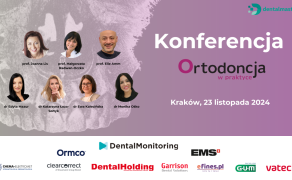Wpływ sił ortodontycznych na stan zębów leczonych endodontycznie
The impact of orthodontic forces on the condition of teeth after endodontic treatment
The topic of adverse side effects of orthodontic treatment and their impact on teeth has been widely discussed in medical literature for many years. These considerations apply to both vital and devitalized teeth. The current prevailing view is that teeth after canal treatment respond to the use of an orthodontic appliance with the same movement as teeth with vital pulp (1-3).
There is a disagreement regarding negative effects associated with the application of forces: it is still popular to think that teeth after endodontic treatment are more susceptible to damage to their root and periodontal structures during movement (1, 2, 4). Wickwire et al. (5) state that teeth deprived of their pulp are more easily resorbed than vital ones. Similar results were reported by Spurrier et al. in their research (2), yet the differences could not be recorded clinically (1). Other researchers, such as Huettner and Young, Mattison et al., and Mah et al. demonstrated the lack of a significant difference in the incidence of adverse side effects of orthodontic treatment in vital and devitalized teeth (3, 6). Whereas Bender et al. observed more frequent resorption in vital teeth than ones deprived of pulp (3, 7).
What stands out in dental literature is a particular direction of the evolution of views regarding the load [...]

którzy są subskrybentami naszego portalu.
i ciesz się dostępem do bazy merytorycznej wiedzy!

































